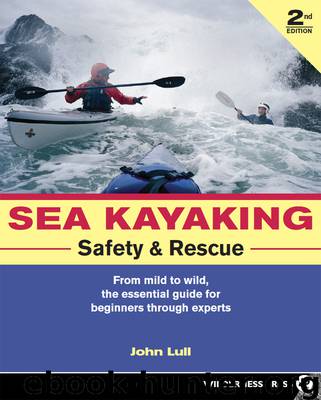Sea Kayaking Safety and Rescue by John Lull

Author:John Lull
Language: eng
Format: epub
ISBN: eBook ISBN| 9780899975474
Publisher: Wilderness Press
Published: 2008-09-03T16:00:00+00:00
When paddling downwind, you can take advantage of the waves. This takes good boat control and surfing skill.
Paddling downwind in steep following seas can be a nightmare or a thrilling pleasure. It all depends on your experience and level of skill. Unless you prefer terror to pleasure, it is well worth gaining the skills to handle following seas. It is also essential to your safety. In really strong wind, your only choice may be to paddle downwind. A kayak can be difficult to control when traveling downwind because the waves tend to push the stern forward while the bow is somewhat locked in as it plows forward though the water. As a result, the boat wants to pivot on the bow and turn broadside to the waves. With practice, you can compensate by using boat lean and corrective sweep strokes. As you sense the boat turning off course, use a sweep stroke to correct. Tilt the boat toward the stroke side, away from the direction you want to turn. In really rough conditions, you can introduce a bracing component to the sweep stroke, by flattening your blade to the water. If your kayak has a rudder or a skeg, it can be used to hold your course. This can save you considerable effort, especially when paddling downwind in a kayak that doesn’t track well.
If the waves are steep enough, you can surf them when traveling downwind. This is exhilarating and will increase your speed considerably. Surfing ability pays huge dividends here. If you have practiced in the surf zone, riding the waves downwind will come naturally. To surf the waves, paddle forward perpendicular to the waves. Aim directly for the wave trough as it opens in front of you. Each time a wave trough passes under your bow, lean forward and paddle hard directly down the face of the next wave rising up behind you. You’ll feel the stern lift, and if you catch the wave, you’ll shoot forward. You may have to lean back to keep the bow from plowing into the wave in front of you. Once you are riding a wave, you can steer with a stern rudder stroke. Try to remain perpendicular to the wave. If you start to turn parallel to the wave, lean the boat toward the wave and use a powerful sweep stroke on the wave side to straighten out. If you are moving fast enough, you can use a stern rudder stroke on the down-wave side while leaning into the wave. However, if you are getting fast rides and making good progress, don’t worry about moving in a perfectly straight line; let the boat yaw back and forth a bit, relax, and enjoy the ride. Surfing downwind is a real joy, once you get comfortable with it.
Boat lean is the key to controlling your kayak in wind and rough seas.
Boat lean (see “Backup Strategy,” Chapter 8) is the key to controlling your kayak in wind and rough seas. Use the lean to maintain a relatively even keel in steep waves.
Download
This site does not store any files on its server. We only index and link to content provided by other sites. Please contact the content providers to delete copyright contents if any and email us, we'll remove relevant links or contents immediately.
Sea Survival Handbook by Keith Colwell(1789)
Fatal Storm by Rob Mundle(1783)
Deep by James Nestor(1779)
Breath by James Nestor;(1754)
The River by Peter Heller(1694)
Lonely Planet Australia by Lonely Planet(1668)
Discover Australia by Lonely Planet(1583)
Iced In by Chris Turney(1576)
Lonely Planet Maldives (Travel Guide) by Planet Lonely & Masters Tom(1423)
One Girl One Dream by Dekker Laura(1352)
Ten Degrees of Reckoning: The True Story of a Family's Love and the Will to Survive by Hester Rumberg(1343)
Looking for a Ship by John McPhee(1316)
Lonely Planet Australia (Travel Guide) by Lonely Planet & Lonely Planet(1306)
Chicken Soup for the Ocean Lover's Soul by Jack Canfield(1287)
South with the Sun by Lynne Cox(1219)
The Wave In Pursuit of the Rogues, Freaks and Giants of the Ocean(1215)
Marlinspike Sailor's Arts and Crafts by Barbara Merry(1205)
Diver Down by Michael Ange(1191)
The Golden Rules: 10 Steps to World-Class Excellence in Your Life and Work by Bob Bowman & Charles Butler(1159)
